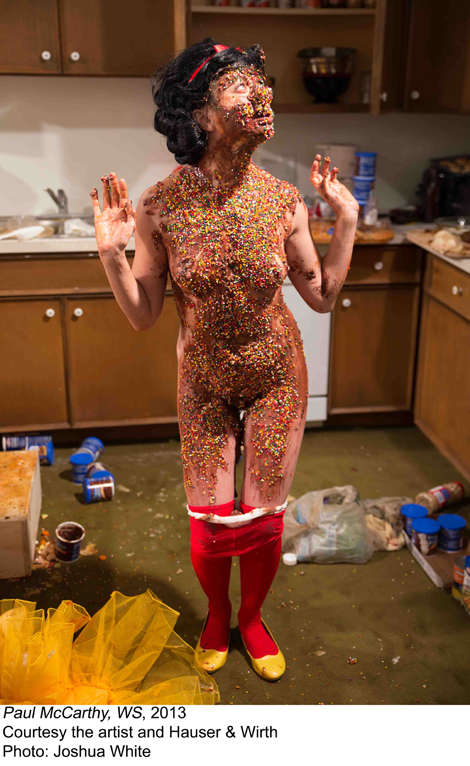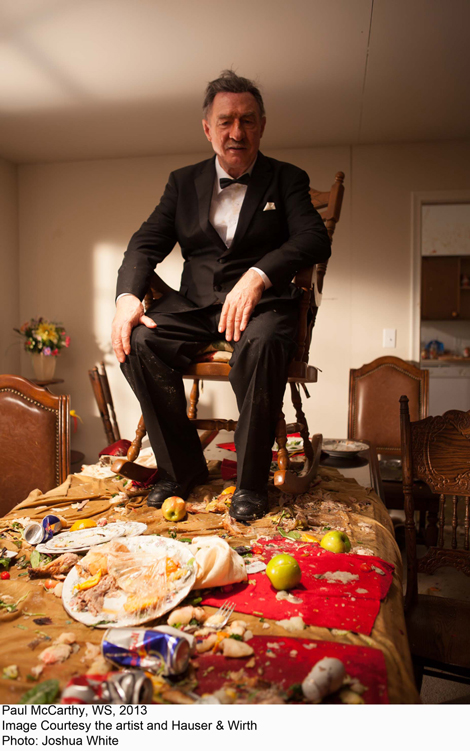It is tempting—though not entirely accurate—to report that this past spring and summer, Paul McCarthy’s new work made a big splash in new york. First we had “Paul McCarthy: Sculpture” at Hauser & Wirth in Chelsea: an exhibition noted for several large, complex, digitally fabricated works in black walnut. Followed there by the video/sculpture installation “Rebel Dabble Babble,” in collaboration with the artist’s son, Damon McCarthy.
The artist’s latest take on the Disneyfication of the tale of Snow White, a multimedia extravaganza titled WS, filled the enormous Park Avenue Armory for seven weeks, and “Paul McCarthy: Life Cast,” an exhibition of five hyper-realist figures and the videos documenting their fabrication, was seen at Hauser & Wirth’s uptown space. The 80-foot-high Balloon Dog greeted visitors to the Frieze fair on Randalls Island back in May, and the slightly twisted Sisters, a massive bronze tableau, haunted the Chelsea waterfront all summer.
The sheer quantity of work was impressive; likewise the range of media and the enormous amount of planning involved in realizing these projects more or less simultaneously. Whether the psychically untethered spirit of McCarthy’s multifarious activities survives this newfound institutional approbation in the long run remains to be seen, but for now—unquietly entering a mature, baroque phase of production—the artist shows few signs of creative ossification, and none whatsoever of cleaning up his act.
Yet the splash all this work made was only medium-sized. The New York art world seems mildly curious but not particularly enthusiastic about what McCarthy & Son have been getting up to. The tepid response points to several difficulties McCarthy’s work presents.
Possibly there was too much to see: WS alone involves 21 hours of video on 10 screens, plus the complex set on which the videos were shot (back in LA). It is a loosely scripted and wildly associative reworking of the Grimms’ tale, fleshing out the part where Snow White gets to know the seven dwarves. The voice of authority is embodied not in an evil stepmother but instead a Disney/McCarthy hybrid named Walt Paul; fluids and food abound in a number of raucous party scenes, bringing to mind the moments of comestibles-related cinematic frenzy in Animal House and Texas Chainsaw Massacre. No doubt many visitors to WS didn’t happen to catch the masturbation and urination/water sports scenes that earned the show its de facto X rating. Editing is rarely a priority for McCarthy, and there is a certain consciousness-altering effect in becoming immersed in his alternative standard of time. But WS is just a whole lot to process.
Perhaps the work’s difficulty is a matter of form—or rather, formlessness. McCarthy rides the monster wave of inchoate meaning without ever reaching the sandy beach of clarity. “I distrust linear language to explain anything,” he told a roomful of pre-opening visitors to “Rebel Dabble Babble,” in response to a question from the audience regarding the general unintelligibility of the videos’ dialogue. “Rebel Dabble Babble,” we are informed, is based on McCarthy’s imaginings of the psychosexual entanglement and power dynamics among Nicolas Ray, Natalie Wood and James Dean in their shared bungalow at the Chateau Marmont during the filming of Ray’s Rebel Without a Cause. The saga of sadism and abuse unfolds on 13 screens and, like WS, is augmented by reconstructions of the sets themselves. And while the actors’ body language implies broad-based emotional manipulation, sexual predation, humiliation and lust for revenge, the piece isn’t for viewers who dislike not knowing at least approximately what is going on.
McCarthy told that same audience that his 1977 work, Sailor’s Meat, was “pivotal” in his development as an artist. A solo performance documented in photographs, Sailor’s Meat features the young McCarthy in a blonde wig, blue eyeliner and little else, enjoying intimate relations with a variety of foodstuffs including a pile of ground beef. Thus began the artist’s program of “resistance to the conditions of culture,” which has since become focused on the idea of patriarchy as an expression of the societal control of social dysfunction.
Patriarchal domination finds concrete form in the representation of domestic architecture, which functions throughout McCarthy’s oeuvre as pressure cooker rather than shelter. In performance videos such as Bossy Burger (1991) and Painter (1995), the set itself is an ominous presence, both channeling and constraining the protagonist’s movements and, by extension, his creative will. (“I referred to the set as a trap,” McCarthy has said. “You entered it and you couldn’t get out.”) When Walt Paul lumbers up onto the table in the Dinner Party scene in WS, bellowing madly at the reveling dwarves and their guests before plunging his face into a mysterious bowl of slop, he nearly bangs his head on the ceiling as if his huffing and puffing might blow the house down. But estrangement from architecture is a tough sell in New York, where being stuck in cramped quarters with unpleasant people is the natural order of things.
Another difficulty is that WS is a work in progress—to quote the artist, “a device that’s now in presentation mode”—on which he expects to continue work after its return to LA. Of course, McCarthy goes to great lengths to avoid narrative resolution in the first place, putting such elements as character development, motivation, plot and dénouement through the shredder. Certainly, presenting an unfinished work in such a grand manner, to such fanfare, is a ballsy move—the ends aren’t just loose, they’re not even ends—but its unfinishedness does nothing to insulate McCarthy from the obvious criticism that WS is by any objective standard an unholy mess.
I happen to like much of McCarthy’s work, but I can understand why someone might not. There’s a tremendous amount of slack framing those riveting moments of tension. That is what makes the work interesting to look at, and to think and talk about. So the recent art-world beatification of the dark clown of performance art is curious to behold, and a hopeful sign. The official embrace of a fervently anti-institutional troublemaker like McCarthy offers a reason to believe that the powers-that-be have a sense of humor, after all.





